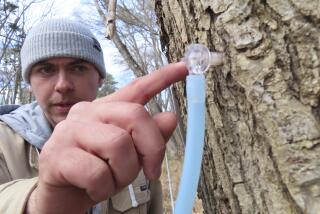The Sweet Life of Two Fudge Makers
- Share via
A 9-year-old girl studied me narrowly as I ordered a hamburger. Suddenly she pointed at me and crowed, “You’ve been to the fudge store!”
Wow. What gave me away? The bit of chocolate I was licking from the corner of my mouth? The shopping bag with the words “Heminger’s Fudge” on it?
For the record:
12:00 a.m. Dec. 21, 1997 For the Record
Los Angeles Times Sunday December 21, 1997 Home Edition Food Part H Page 2 Food Desk 1 inches; 19 words Type of Material: Correction
Charles Perry’s story on fudge maker Fred Heminger incorrectly identified Harbor Springs as being in Minnesota. It is in Michigan.
Or maybe there’s just an air about people who’ve been sampling fudge. This little girl will have plenty of opportunity to observe it if she hangs around much at Gottschalk’s Department Store in San Bernardino, where Fred and Susan Heminger have a fudge shop. There’s nothing like the sight of 26 pounds of fudge being worked on a big marble tabletop to get people into a fudge-sampling mood.
The Hemingers grew up in fudge. They were childhood sweethearts in Harbor Springs, Minn., just about 25 miles from the resort community of Mackinac Island (pronounced “Mackinaw”), which claims to be the original home of fudge.
“Fudge was invented in Mackinac Island 107 years ago,” says Fred Heminger. “Three guys are claimed to be the inventor: May, Murdoch and Ryba. They still have arguments about it up there.”
Having worked in a fudge shop together throughout their school days, the Hemingers decided in 1961 to make fudge their life. Fred studied fudge-making with a man named Crumb, who had learned from Murdoch himself. The Hemingers owned several fudge shops in Michigan before moving to California in 1985.
They have invented dozens of new fudge flavors, including rum raisin, chocolate cranberry, French vanilla walnut and Kahlua mocha. This year, after months of trial and error, Fred devised a way to make a pumpkin fudge, which tastes exactly like pumpkin pie filling with a creamy fudge aftertaste.
But otherwise they follow Mackinac Island tradition religiously. They boil the basic mixture of sugar, corn syrup, chocolate and cream in huge copper kettles, because that’s how it’s always been done. They pour it on a traditional marble-topped table about the size of a twin bed.
And there it has to sit for a while. As the super-heated syrup cools, sugar crystals start to form. To get a creamy texture, you want a lot of tiny crystals evenly distributed in the mixture.
But working the mixture, necessary to get even distribution, also stimulates crystallization. If you start working it too soon, when only a few crystals have formed, they’ll grow large and make a grainy fudge. The same thing happens if you stop at any point in working the fudge. It will coarsen right before your eyes.
On the Hemingers’ marble-topped table, the syrup is held in place by thick stainless steel bars as it cools. When it loses its gloss and starts getting a satiny look, indicating that crystals are forming, Fred pulls a bar away to test the consistency. He doesn’t add nuts and vanilla until the mass has cooled, because he feels the nuts get soggy otherwise, and he uses real vanilla, which doesn’t tolerate high temperatures. Finally, he starts to work the fudge.
Crystallization is greatest at the bottom of the mass, because the marble slab absorbs heat. “When we’re making a lot of batches,” says Fred, “we actually cool off the slabs in between with ice.” So as he works the fudge with a long-handled ice scraper, he continually shovels the bottom fudge to the top, where it stimulates more crystallization. “It acts almost like yeast in bread,” he says.
Eventually he switches to hand scrapers for better control. “As it grains up,” he says, “you can hear a different sound on the marble.”
He ends up with a long log of fudge. It’s delicious--melting in texture, with a wonderfully creamy flavor. However, there’s a trade-off. Making fudge the traditional way, Heminger can make only 26 pounds in a batch. In his back room, he has storage racks for just about 800 pounds of fudge.
As a result, he can never keep up with demand at Christmas, his biggest season. “From Dec. 5,” he says, “we’re getting more and more behind.”
Yeah, but it’s a sweet life. I’ve met a little girl who’d obviously give anything to make fudge her life.
Heminger’s fudge is sold at Heminger fudge shops in San Bernardino, Watsonville, Visalia and Palm Springs and by mail at (800) OK-FUDGE.
More to Read
Eat your way across L.A.
Get our weekly Tasting Notes newsletter for reviews, news and more.
You may occasionally receive promotional content from the Los Angeles Times.










